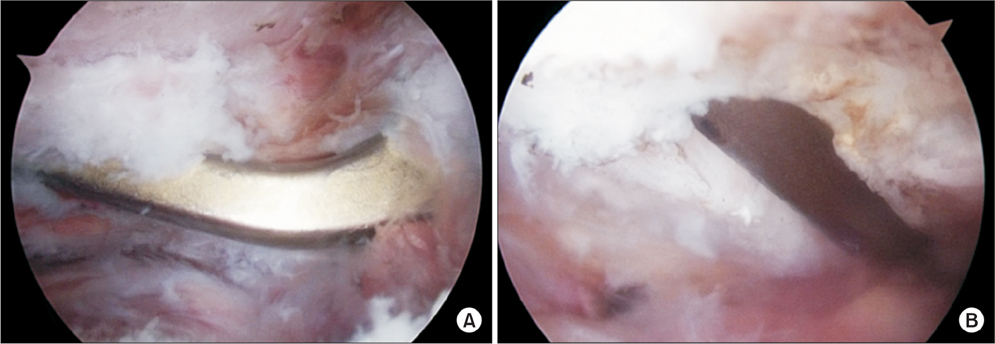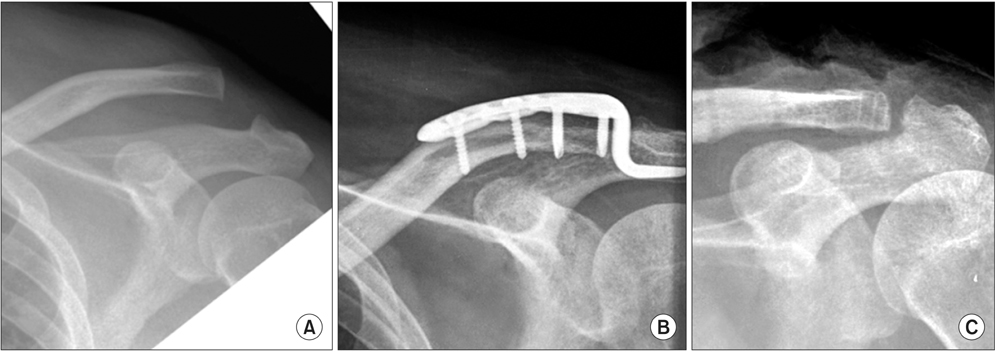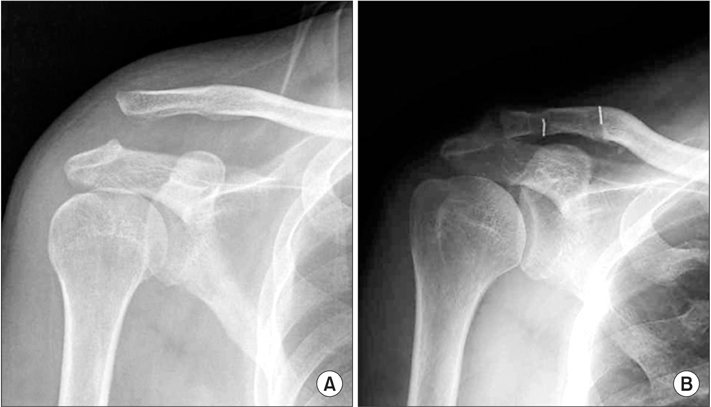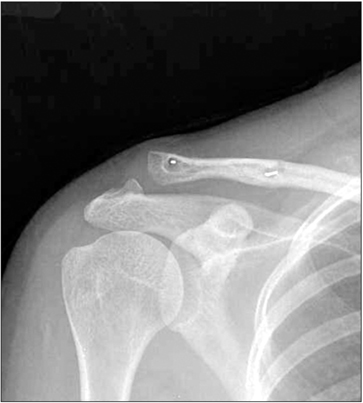Clin Orthop Surg.
2015 Mar;7(1):97-103. 10.4055/cios.2015.7.1.97.
Comparison of Results between Hook Plate Fixation and Ligament Reconstruction for Acute Unstable Acromioclavicular Joint Dislocation
- Affiliations
-
- 1Department of Orthopaedic Surgery, Kyungpook National University Hospital, Kyungpook National University School of Medicine, Daegu, Korea.
- 2Department of Orthopaedic Surgery, Konkuk University School of Medicine, Seoul, Korea.
- 3Department of Orthopedic Surgery, Seoul National University Bundang Hospital, Seoul National University College of Medicine, Seongnam, Korea. ohjh1@snu.ac.kr
- KMID: 2069881
- DOI: http://doi.org/10.4055/cios.2015.7.1.97
Abstract
- BACKGROUND
In the present study, we aimed to compare clinical and radiographic outcomes between hook plate fixation and coracoclavicular (CC) ligament reconstruction for the treatment of acute unstable acromioclavicular (AC) joint dislocation.
METHODS
Forty-two patients who underwent surgery for an unstable acute dislocation of the AC joint were included. We divided them into two groups according to the treatment modality: internal fixation with a hook plate (group I, 24 cases) or CC ligament reconstruction (group II, 18 cases). We evaluated the clinical outcomes using a visual analog scale (VAS) for pain and Constant-Murley score, and assessed the radiographic outcomes based on the reduction and loss of CC distance on preoperative, postoperative, and final follow-up plain radiographs.
RESULTS
The mean VAS scores at the final follow-up were 1.6 +/- 1.5 and 1.3 +/- 1.3 in groups I and II, respectively, which were not significantly different. The mean Constant-Murley scores were 90.2 +/- 9.9 and 89.2 +/- 3.5 in groups I and II, respectively, which were also not significantly different. The AC joints were well reduced in both groups, whereas CC distance improved from a mean of 215.7% +/- 50.9% preoperatively to 106.1% +/- 10.2% at the final follow-up in group I, and from 239.9% +/- 59.2% preoperatively to 133.6% +/- 36.7% at the final follow-up in group II. The improvement in group I was significantly superior to that in group II (p < 0.001). Furthermore, subluxation was not observed in any case in group I, but was noted in six cases (33%) in group II. Erosions of the acromion undersurface were observed in 9 cases in group I.
CONCLUSIONS
In cases of acute unstable AC joint dislocation, hook plate fixation and CC ligament reconstruction yield comparable satisfactory clinical outcomes. However, radiographic outcomes based on the maintenance of reduction indicate that hook plate fixation is a better treatment option.
MeSH Terms
Figure
Reference
-
1. Oussedik S. Injuries to the clavicle and acromioclavicular joint. Br J Hosp Med (Lond). 2007; 68(4):M68–M70.
Article2. Willimon SC, Gaskill TR, Millett PJ. Acromioclavicular joint injuries: anatomy, diagnosis, and treatment. Phys Sportsmed. 2011; 39(1):116–122.
Article3. Ceccarelli E, Bondi R, Alviti F, Garofalo R, Miulli F, Padua R. Treatment of acute grade III acromioclavicular dislocation: a lack of evidence. J Orthop Traumatol. 2008; 9(2):105–108.
Article4. Duan X, Zhang H, Zhang H, Wang Z. Treatment of coracoid process fractures associated with acromioclavicular dislocation using clavicular hook plate and coracoid screws. J Shoulder Elbow Surg. 2010; 19(2):e22–e25.
Article5. Phillips AM, Smart C, Groom AF. Acromioclavicular dislocation: conservative or surgical therapy. Clin Orthop Relat Res. 1998; (353):10–17.6. Spencer EE Jr. Treatment of grade III acromioclavicular joint injuries: a systematic review. Clin Orthop Relat Res. 2007; 455:38–44.7. Bannister GC, Wallace WA, Stableforth PG, Hutson MA. The management of acute acromioclavicular dislocation: a randomised prospective controlled trial. J Bone Joint Surg Br. 1989; 71(5):848–850.
Article8. Hoffler CE, Karas SG. Transacromial erosion of a locked subacromial hook plate: case report and review of literature. J Shoulder Elbow Surg. 2010; 19(3):e12–e15.
Article9. Johansen JA, Grutter PW, McFarland EG, Petersen SA. Acromioclavicular joint injuries: indications for treatment and treatment options. J Shoulder Elbow Surg. 2011; 20:2 Suppl. S70–S82.
Article10. Simovitch R, Sanders B, Ozbaydar M, Lavery K, Warner JJ. Acromioclavicular joint injuries: diagnosis and management. J Am Acad Orthop Surg. 2009; 17(4):207–219.
Article11. Di Francesco A, Zoccali C, Colafarina O, Pizzoferrato R, Flamini S. The use of hook plate in type III and V acromioclavicular Rockwood dislocations: clinical and radiological midterm results and MRI evaluation in 42 patients. Injury. 2012; 43(2):147–152.
Article12. Eschler A, Gradl G, Gierer P, Mittlmeier T, Beck M. Hook plate fixation for acromioclavicular joint separations restores coracoclavicular distance more accurately than PDS augmentation, however presents with a high rate of acromial osteolysis. Arch Orthop Trauma Surg. 2012; 132(1):33–39.
Article13. von Heideken J, Bostrom Windhamre H, Une-Larsson V, Ekelund A. Acute surgical treatment of acromioclavicular dislocation type V with a hook plate: superiority to late reconstruction. J Shoulder Elbow Surg. 2013; 22(1):9–17.
Article14. Jeon IH, Dewnany G, Hartley R, Neumann L, Wallace WA. Chronic acromioclavicular separation: the medium term results of coracoclavicular ligament reconstruction using braided polyester prosthetic ligament. Injury. 2007; 38(11):1247–1253.
Article15. Nuchtern JV, Sellenschloh K, Bishop N, et al. Biomechanical evaluation of 3 stabilization methods on acromioclavicular joint dislocations. Am J Sports Med. 2013; 41(6):1387–1394.
Article16. Yoo YS, Seo YJ, Noh KC, Patro BP, Kim DY. Arthroscopically assisted anatomical coracoclavicular ligament reconstruction using tendon graft. Int Orthop. 2011; 35(7):1025–1030.
Article17. Mares O, Luneau S, Staquet V, Beltrand E, Bousquet PJ, Maynou C. Acute grade III and IV acromioclavicular dislocations: outcomes and pitfalls of reconstruction procedures using a synthetic ligament. Orthop Traumatol Surg Res. 2010; 96(7):721–726.
Article18. Bafus BT, Hughes RE, Miller BS, Carpenter JE. Evaluation of utility in shoulder pathology: correlating the American Shoulder and Elbow Surgeons and Constant scores to the EuroQoL. World J Orthop. 2012; 3(3):20–24.
Article19. Flinkkila T, Ristiniemi J, Lakovaara M, Hyvonen P, Leppilahti J. Hook-plate fixation of unstable lateral clavicle fractures: a report on 63 patients. Acta Orthop. 2006; 77(4):644–649.
Article20. Hackenbruch W, Regazzoni P, Schwyzer K. Surgical treatment of lateral clavicular fracture with the "clavicular hooked plate". Z Unfallchir Versicherungsmed. 1994; 87(3):145–152.21. Meda PV, Machani B, Sinopidis C, Braithwaite I, Brownson P, Frostick SP. Clavicular hook plate for lateral end fractures: a prospective study. Injury. 2006; 37(3):277–283.
Article22. Salem KH, Schmelz A. Treatment of Tossy III acromioclavicular joint injuries using hook plates and ligament suture. J Orthop Trauma. 2009; 23(8):565–569.
Article23. ElMaraghy AW, Devereaux MW, Ravichandiran K, Agur AM. Subacromial morphometric assessment of the clavicle hook plate. Injury. 2010; 41(6):613–619.
Article24. Chiang CL, Yang SW, Tsai MY, Kuen-Huang Chen C. Acromion osteolysis and fracture after hook plate fixation for acromioclavicular joint dislocation: a case report. J Shoulder Elbow Surg. 2010; 19(4):e13–e15.
Article25. Carofino BC, Mazzocca AD. The anatomic coracoclavicular ligament reconstruction: surgical technique and indications. J Shoulder Elbow Surg. 2010; 19:2 Suppl. 37–46.
Article26. Jones HP, Lemos MJ, Schepsis AA. Salvage of failed acromioclavicular joint reconstruction using autogenous semitendinosus tendon from the knee. Surgical technique and case report. Am J Sports Med. 2001; 29(2):234–237.
Article27. Rios CG, Mazzocca AD. Acromioclavicular joint problems in athletes and new methods of management. Clin Sports Med. 2008; 27(4):763–788.
Article28. Giannotti S, Dell'osso G, Bugelli G, Cazzella N, Guido G. Surgical treatment of acromioclavicular dislocation with LARS artificial ligament. Eur J Orthop Surg Traumatol. 2013; 23(8):873–876.
Article29. Murena L, Vulcano E, Ratti C, Cecconello L, Rolla PR, Surace MF. Arthroscopic treatment of acute acromioclavicular joint dislocation with double flip button. Knee Surg Sports Traumatol Arthrosc. 2009; 17(12):1511–1515.
Article
- Full Text Links
- Actions
-
Cited
- CITED
-
- Close
- Share
- Similar articles
-
- Crossbar Technique for the Failed Clavicular Hook Plate Fixation in an Acute Acromioclavicular Joint Dislocation: Salvage for Acromial Fracture after Clavicular Hook Plate
- Clinical and Radiologic Outcomes of Acute Acromioclavicular Joint Dislocation: Comparison of Kirschner's Wire Transfixation and Locking Hook Plate Fixation
- Acromion Fracture after Hook Plate Fixation for Distal Clavicle Injury: A Report of 2 Cases
- The Necessity of Coracoclavicular Ligament Repair in Open Reduction for the Acromioclavicular Joint Dislocations
- Hook Plate Fixation for Acute Acromioclavicular Joint Injury: Results of 112 Patients and Evaluation of Differences Depending on the Type of Plate and whether Coracoclavicular Ligament Repair was Performed





